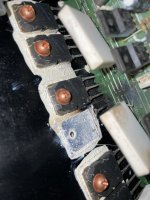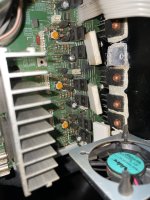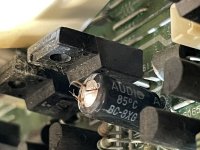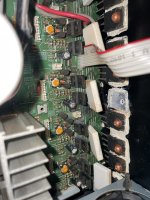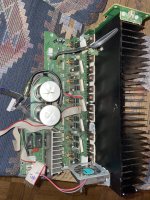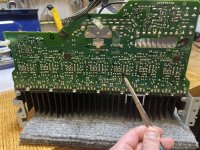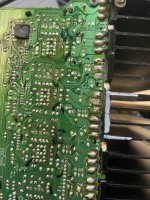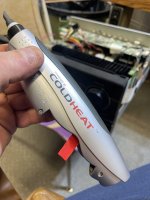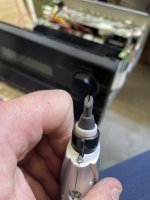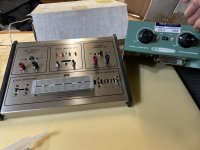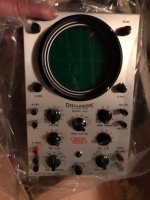Hello everyone I’m a new member with some knowledge of electrical, but the wrong kind.
I have a onkyo tx-nr807 receiver that I was playing the music way loud a few years ago and it turned off so I came back inside and turned it back on and as I walked away, it was shorting out sparks everywhere. I unplugged it weeks later it took it apart, took the screw out of where it shorted in the transistor? I believe and plugged it back in. Turned it back on and poof. A capacitor went . I left it and forgot about it.
Now I am off work for a long time because of an injury and I’ve taken it apart but I’m at a point where I need to order parts or figure out what to do and I’m looking for a little advice or lead me in the right direction.
I’ll post pictures that I have taken thanks
I have a onkyo tx-nr807 receiver that I was playing the music way loud a few years ago and it turned off so I came back inside and turned it back on and as I walked away, it was shorting out sparks everywhere. I unplugged it weeks later it took it apart, took the screw out of where it shorted in the transistor? I believe and plugged it back in. Turned it back on and poof. A capacitor went . I left it and forgot about it.
Now I am off work for a long time because of an injury and I’ve taken it apart but I’m at a point where I need to order parts or figure out what to do and I’m looking for a little advice or lead me in the right direction.
I’ll post pictures that I have taken thanks
Attachments
Welcome to diyAudio 🙂
Although all the circuitry in this looks fairly conventional its also fair to say it may well be to ambitious as a first project. Looking at the cap number that has popped suggests that this will be a typical rebuild and check of the output stage. All the additional component failures are going to be collateral damage.
C6020 is this one and failure as you show means that the output transistors, the driver pair and the pre drivers are all likely to have suffered collateral damage along with the any/all of the low value resistors.
You would need to be able to not only replace failed parts but also be confident about powering it up on a current limit supply when first re testing it.

Although all the circuitry in this looks fairly conventional its also fair to say it may well be to ambitious as a first project. Looking at the cap number that has popped suggests that this will be a typical rebuild and check of the output stage. All the additional component failures are going to be collateral damage.
C6020 is this one and failure as you show means that the output transistors, the driver pair and the pre drivers are all likely to have suffered collateral damage along with the any/all of the low value resistors.
You would need to be able to not only replace failed parts but also be confident about powering it up on a current limit supply when first re testing it.
I have nothing to lose by trying. I know that this is probably to advance for my skill but when I’m explained what to do I can usually figure it out. I do listen
I don’t understand the drawing. I thought that it was the L speaker. I don’t use the surround. (Maybe when it got hot it was just the weakest link.). Could you circle the parts with the names that I should replace if I see it I can understand better. I also found a burn on the bottom. I’ll send pic.
Also what is the stuff behind the transducer. Is it a type of ground isolation and the white stuff?
I don’t understand the drawing. I thought that it was the L speaker. I don’t use the surround. (Maybe when it got hot it was just the weakest link.). Could you circle the parts with the names that I should replace if I see it I can understand better. I also found a burn on the bottom. I’ll send pic.
Also what is the stuff behind the transducer. Is it a type of ground isolation and the white stuff?
Attachments
The amp has multiple sections (front, rear, surround etc that are essentially the same. I picked that particular one (diagram) becuase it seemed to fit with the cap reference number of C6020

The transistors are electrically isolated from the heatsink by those thin washers which could be mica (thin and brittle) or a synthetic compound. The white stuff is thermal grease to transfer heat from the metal tab of the transistor to the heatsink via the washer.
I haven't got the circuit in front of me here but if you don't use surround then if those channels have the same type number transistors... well you might be able to rebuild that channel using parts from the non used ones.
Can't just make out what the burn is, whether it has been caused by something on the other side of the board or whether it is a poor joint in its own right.
All the transistors in that image of mine would be suspect because of the failure mode causing damage to other parts. All the resistors under 1k ohm in value in that image need checking to make sure none have gone high or open circuit due to current overload.
The transistors are electrically isolated from the heatsink by those thin washers which could be mica (thin and brittle) or a synthetic compound. The white stuff is thermal grease to transfer heat from the metal tab of the transistor to the heatsink via the washer.
I haven't got the circuit in front of me here but if you don't use surround then if those channels have the same type number transistors... well you might be able to rebuild that channel using parts from the non used ones.
Can't just make out what the burn is, whether it has been caused by something on the other side of the board or whether it is a poor joint in its own right.
All the transistors in that image of mine would be suspect because of the failure mode causing damage to other parts. All the resistors under 1k ohm in value in that image need checking to make sure none have gone high or open circuit due to current overload.
So I swapped out surround and installed it on L. Soldering is not as easy as I thought it was. Could use a magnifying glass for those little tiny pieces. Here’s my finish job and gonna put it back together quickly and see if it turns back on.
Attachments
I see at least three burnt out tracks.
And a board full of dry solder joints.
And a board full of dry solder joints.
Well it didn’t blow up when plugged in. Is there any I can do about track and solder. Could you circle where you see the problems?
I honestly think you are going to have to accept that this is outside your comfort zone. Soldering, desoldering, these are all skills that need to be learned.
Well it didn’t blow up when plugged in. Is there any I can do about track and solder. Could you circle where you see the problems?
I also have a cold soldering machine. It didn’t work well for soldering big wire but maybe this will help.
I'm with Mooly.
I will add.
If you are unable to locate the obvious failures on the board,
and need to ask "what's the stuff is behind the transducers", then I'm afraid to say this is way beyond your current abilities.
Stop, put it back together, and take it to a repair shop Before you hurt or kill yourself or someone you love.
Futsing with things you don't understand will also make it harder (and more costly) for the repairer to repair as they will have to sort through the genuine faults as well as the new introduced faults.
Edit.
And after looking at pictures of this unit.
Yeah NO.
It's a multi channel device with processors and digital controls through out.
In other words, A technicians nightmare.
My advise would be to class it as a write off as repairs (if anyone would touch it) would exceed its value, and go buy a new something.
Last edited:
From Amazon - Customer review of that receiver:
I bought the unit back in Oct but I didn't set it up until Dec as that was when I bought my new plasma tv. The unit worked great, excellent picture good sound, for about an hour and half at which time the sound cut out. I tried all the troubleshooting steps listed in the instructions to no avail. I contacted Onkyo and they said I'd have to send it to an authorized repair store on my dime but that it was still under warranty so the repairs would be free and the repair shop would ship it back to me for free. All that took place though the repair shop called me twice to let me know they were ordering new parts so it ended up taking around a month to get the unit back. Got it hooked it up again and again I was happy with the pic and sound then after using it for around three hours then, while watching the blu-ray of Amadeus during the Don Giovanni scene, the sound cuts out again and a plume of smoke rose from the unit. So I'll be on the phone with Onkyo and probably the repair shop on Monday (Sunday now) to see whats what. I realize I'm probably just unlucky and have a especially poorly constructed unit but I can't recommend this unit.
I'm afraid it's not worth fixing. 🙄
I bought the unit back in Oct but I didn't set it up until Dec as that was when I bought my new plasma tv. The unit worked great, excellent picture good sound, for about an hour and half at which time the sound cut out. I tried all the troubleshooting steps listed in the instructions to no avail. I contacted Onkyo and they said I'd have to send it to an authorized repair store on my dime but that it was still under warranty so the repairs would be free and the repair shop would ship it back to me for free. All that took place though the repair shop called me twice to let me know they were ordering new parts so it ended up taking around a month to get the unit back. Got it hooked it up again and again I was happy with the pic and sound then after using it for around three hours then, while watching the blu-ray of Amadeus during the Don Giovanni scene, the sound cuts out again and a plume of smoke rose from the unit. So I'll be on the phone with Onkyo and probably the repair shop on Monday (Sunday now) to see whats what. I realize I'm probably just unlucky and have a especially poorly constructed unit but I can't recommend this unit.
I'm afraid it's not worth fixing. 🙄
I completely understand your concern for safety and death. But I’m a journeyman welder and work around more dangerous things than these transformers. And when I have a helper, that doesn’t know what he’s doing, I said to them it’s better to ask questions then F*** up.
I can wire a house and install 220 sub panels but the small stuff is just confusing.
All I’m saying is that I’m am aware of the risks and damage to my receiver but why not give it a try.
Please let me make decision to give up. I’ll know when it’s time.
I can wire a house and install 220 sub panels but the small stuff is just confusing.
All I’m saying is that I’m am aware of the risks and damage to my receiver but why not give it a try.
Please let me make decision to give up. I’ll know when it’s time.
I sent mine to onkyo. this same one about seven years ago and they fixed the picture. No sound problem. It was the hdmi/network board.From Amazon - Customer review of that receiver:
I bought the unit back in Oct but I didn't set it up until Dec as that was when I bought my new plasma tv. The unit worked great, excellent picture good sound, for about an hour and half at which time the sound cut out. I tried all the troubleshooting steps listed in the instructions to no avail. I contacted Onkyo and they said I'd have to send it to an authorized repair store on my dime but that it was still under warranty so the repairs would be free and the repair shop would ship it back to me for free. All that took place though the repair shop called me twice to let me know they were ordering new parts so it ended up taking around a month to get the unit back. Got it hooked it up again and again I was happy with the pic and sound then after using it for around three hours then, while watching the blu-ray of Amadeus during the Don Giovanni scene, the sound cuts out again and a plume of smoke rose from the unit. So I'll be on the phone with Onkyo and probably the repair shop on Monday (Sunday now) to see whats what. I realize I'm probably just unlucky and have a especially poorly constructed unit but I can't recommend this unit.
I'm afraid it's not worth fixing. 🙄
No offense intended, but this is beyond your capabilities. The device is too complicated, and probably has some factory error. It is probably a challenge for factory service as well. And that can only mean that the repair is too expensive.
No offense taken.
Do you think I can at least fix the board. Yes I do believe everything else is over my head
Do you think I can at least fix the board. Yes I do believe everything else is over my head
I do not know what to tell you. The procedure is to detect and replace all defective parts, repair the lines on the PCB if they are broken, and resolder all bad connections. You need a lot of equipment for that, a good soldering iron, desoldering pump, some measuring instruments, some experience in electronics.
Ok I guess I’ll go price out a replacement board. To see if it is worth fixing or replacing.
I still appreciate everyone’s help. Thank you all
I still appreciate everyone’s help. Thank you all
1st one is a 'breadboard' in a fancy enclosure. Used to prototype and build circuits on. You could build an amplifier in prototype form on those for example.

2nd one is an oscilloscope which measures (and traces out) voltage against time. It is used to look at changing voltages as it happens. The squares on the screen are calibrated against the vertical (voltage) and horizontal axis (time).

2nd one is an oscilloscope which measures (and traces out) voltage against time. It is used to look at changing voltages as it happens. The squares on the screen are calibrated against the vertical (voltage) and horizontal axis (time).
First thing, that Apollo-era digital protoboard is useless.
The latter, the oscilloscope, is also very old, but maybe it can be useful if it is in working order and if you know how to use it. If it has been in storage for decades, there may be problems with the electrolytic capacitors when it is turned on. There could be electrolytic caps bloat and some white smoke, you never know. It also needs a signal generator.
The latter, the oscilloscope, is also very old, but maybe it can be useful if it is in working order and if you know how to use it. If it has been in storage for decades, there may be problems with the electrolytic capacitors when it is turned on. There could be electrolytic caps bloat and some white smoke, you never know. It also needs a signal generator.
- Home
- Amplifiers
- Power Supplies
- Receiver shorted out and smoked
